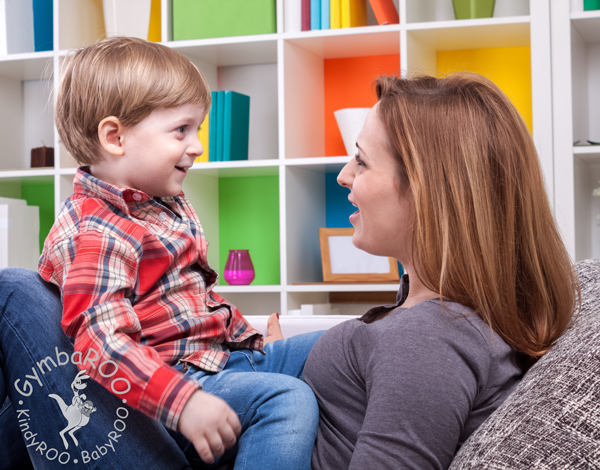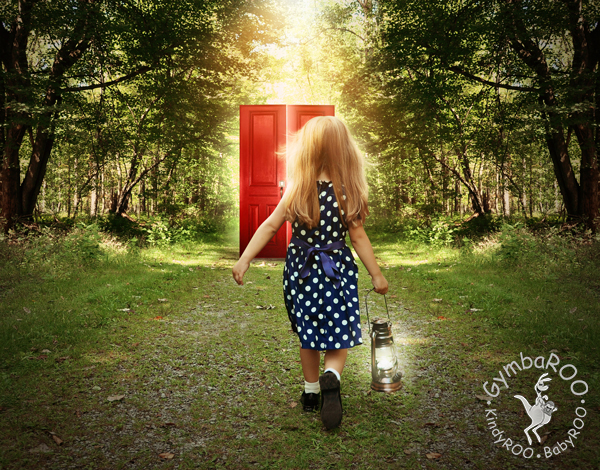Join the thousands of parents already raising smarter, happier babies with our online baby classes: The Active Babies Smart Kids series. Click here.
GymbaROO-KindyROO kids are excelling academically, emotionally, in leadership roles and on the sporting field. Find us at: GymbaROO-KindyROO
Telling stories awakens wonder and creates special occasions with children, whether it is bedtime, around the fire or on rainy days. Author Nancy Mellon (2006)[i]
Children love to listen to stories. Storytelling is embedded in the casual language of families, friends and workmates. Stories are told by parents and grandparents who want to pass on an event in family history or tell tales about their childhood, or by friends who pass on information, their experiences or simply entertain. Teachers appreciate the value of storytelling in building a bank of story plots, structures, settings and characters to be drawn on in children’s writing. Storytelling is part of life.
Storytelling is an ancient form of communication whereby traditions, myths, legends, oral fairy tales and important events in history have been disseminated throughout the ages. Storytelling transmits ideas through the spoken word in a tale that often reflects the voice of the storyteller or the era in which it is told. According to Albers (2016)[ii]oral stories also convey ‘beliefs, attitudes and social norms which, in turn, shape children’s perceptions of reality’.
Oral storytelling has been shown to enhance emerging literacy and language development in young children, and provide familiar templates that can be remembered and drawn upon in later life. While reading books to your child is essential and the traditional way to enhance literacy skills, numerous researchers have listed the positive consequences of telling stories to young children. Phillips (2000)[iii]found storytelling builds connections between the teller and listener, enhances memory, supports early literacy development and creative thinking. As a potential key to emergent literacy, oral storytelling interactions between parents and young children from birth to five years appear to be, ‘just as important as reading to children’. Cutspec (2006)[iv]
The difference between reading from a book and telling a story is that the oral story is malleable. It can be adapted to circumstances or allow the listener to join in by repeating phrases, actions and sounds. Variations may be suggested as stories become familiar to the child. Roney [v] (1996) labeled this important aspect of storytelling ‘co-creativity’ as teller and listener connect and build a story together.
Stories ‘told’ rather than ‘read’ take on a different dimension as the child’s senses can be evoked to enhance the story. Memories of smells linger and create connections to previous knowledge (eucalyptus leaves on a hot day), while sounds can be invoked to give a sense of time and place (the train going through the boom gates on our drive to the city), favourite tastes (the first spoonful of ice-cream) and even touch (my cat’s fur as she brushes against me).
The storyteller is able to model clear articulation and language skills, present literary devices such as building climax, plot and characterisation and introduce visualisation skills as children imagine new worlds and cultures. Most importantly the storyteller can develop a unique connection with their child or children.
By being active listeners, children’s attention spans are stretched, their vocabulary is increased, they learn to listen and hold eye contact. Children also hear the way language sounds and can be varied using forms such as rhyme, alliteration and repetition. Oral stories are an enjoyable exercise in memory making as children remember key points of the plot, specific actions or sounds created for different parts of the story. The auditory aspect of storytelling encourages children to provide their own imagery.
Retelling a familiar story also builds complex links between cognitive processes (knowledge, understanding, analysis, judgment), gross and fine motor skills (gestures and actions) and interpretation (feelings).
What if you don’t feel that you are a natural storyteller?
Here are some tips
- Re-tell an old story that you know and enjoyed when you were a child, perhaps a fairy tale or fable.
- Retell stories that follow patterns and that you can remember easily like ‘We’re going on a bear hunt’ or ‘There was an old woman who swallowed a fly’.
- Tell your child funny stories about their babyhood.
- Find an interesting ancestor who did something intriguing. Everyone has at least one such relative!
- Invent or retell a story from your childhood and, as it’s your story, you can change or modify it.
- Don’t be afraid to use props, act the story out, or have a special place like ‘a story tent’ that you and your child snuggle into.
- Tell the story again and again. Children love repetition.
- Seek out storytelling associations[vi]or watch storytellers at local events for ideas.
- And… understand children might interrupt because they are so engaged they want to add something. Soon you’ll be the listener.
Dr. Robyn Floyd is a Principal who researches early Australian fairytales and enjoys telling magical ‘made-up’ stories to her grandchildren.
References
[i] Mellon, N. (2013), Storytelling with children. Stroud: Hawthorn Press. [ii] Albers, P. (2016), Why stories matter for children’s learning, in The Conversation Accessed March 2017, https://theconversation.com [iii] Phillips, L. (1999), The role of storytelling in early literacy development. Accessed March 2017 from http://www.australianstorytelling.org.au/storytelling-articles/n-s/role-of-storytelling-in-early-literacy-development-louise-phillips [iv] Cutspec, P (2006), Oral Storytelling within the Context of the Parent-Child Relationship, Vol. 2, No. 2, Talaris Research Institute, Seattle, Washington. [v] Roney, R.C. (1996), Storytelling in the classroom: Some theoretical thoughts. Storytelling World, 9, 7-9. [vi] http://www.storytellingvic.org.au https://www.australianstorytelling.org.au
GymbaROO-KindyROO
Thousands of parents, babies and children are presently involved in our programs and creating rising stars. GymbaROO-KindyROO kids are excelling academically, emotionally, in leadership roles and on the sporting field. Come join all the fun and learning! “GymbaROO – The best decision I ever made for my child.” Classes from 6 weeks old – 7 years GymbaROO KindyROO
Active Babies Smart Kids – Online Baby Classes
GymbaROO-KindyROO’s online series of baby classes is taking the parenting world by storm! It is highly recommended by doctors, paediatricians, early childhood experts and the Maternal Child and Family Health Nurses Association. This series is being called: “The essential guide for parents”. Join the thousands of parents already playing with their babies from birth, in the best way for brain and body development and laying crucial foundations for future learning. What happens in the first year, not only matters, it matters a lot!
Click here: Active Babies Smart Kids online series of baby classes
Try the first episode FREE: Tummy time + baby fun and development class 1
Enjoy the following GymbaROO-KindyROO articles
GymbaROO-KindyROO: Who, what, where, why and how
All about GymbaROO-KindyROO’s online baby classes for parents and babies: Active Babies Smart Kids
When will my baby / toddler become right or left handed?
Reading to babies and children gives them an early cognitive advantage. New research.
Encouraging conversation – so important to development. Why and how.
School Readiness: Is my child ready for school? A checklist
NAPLAN results improve with LESS reading and maths and MORE GymbaROO.
To my elected childcare, preschool or school: Please include a GymbaROO sensory-motor program.

